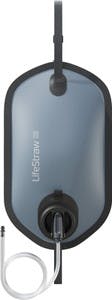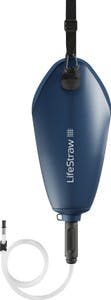Lifestraw
- brand:LifeStraw
- (21)LifeStraw Membrane Microfilter Replacement$26.95
- (119)LifeStraw Sip Reusable Stainless-Steel Water Filter Straw$49.95
- (35)LifeStraw Large Capacity Gravity 8L Water Filter System$134.95
- (26)LifeStraw Peak Series Gravity Water Purifier System, 8L$265.95
- (185)LifeStraw Personal Water Filter Straw$34.95
- (165)LifeStraw Compact Gravity 3L Water Filter System$92.95
- (55)LifeStraw Peak Series Solo Water Filter$41.95
- ‹
- 1
- ›
Compare (0)
About LifeStraw
LifeStraw is committed to providing equitable access to safe drinking water, driving their innovation in water filtration technology. Their mission extends beyond just making products—they actively work to bring clean water solutions to communities in need around the world. The first LifeStraw was introduced in 2005 as a portable water filtration device for humanitarian aid, designed to remove bacteria and parasites from contaminated water sources. Originally created to help communities with limited access to safe drinking water, the LifeStraw quickly became a globally recognized tool for emergency response and outdoor enthusiasts alike. Over the years, the brand has expanded its product line, offering advanced water filtration systems for a wide range of activities, from hiking and camping to travel and home use. You can find all kinds of water filtration tools from LifeStraw at your local MEC or online.
Clean and crisp drinking water anywhere
LifeStraw’s innovative filtration technology ensures that safe drinking water is accessible no matter where you are. Their signature product, the personal water filter straw, allows users to drink directly from lakes, rivers or other natural water sources while filtering out harmful contaminants.
For those needing to filter larger amounts of water, LifeStraw’s gravity-fed systems provide an efficient solution. These filters use gravity to pull water through a filtration membrane, requiring no manual pumping and making them ideal for group camping trips or emergency preparedness. LifeStraw also offers squeeze water bottles with built-in filters, perfect for travelers, hikers and runners who need a quick and portable solution for safe hydration. These collapsible bottles are lightweight and easy to pack, making them a convenient choice for staying hydrated on the go.
Keeping natural water sources clean
As a certified B Corporation, LifeStraw prioritizes sustainability and environmental responsibility. They minimize their ecological footprint by reducing single-use plastics and maximizing the use of recyclable and compostable materials in their products and packaging. Their efforts aim to keep plastic waste out of oceans and landfills while promoting long-term solutions for clean water access.







